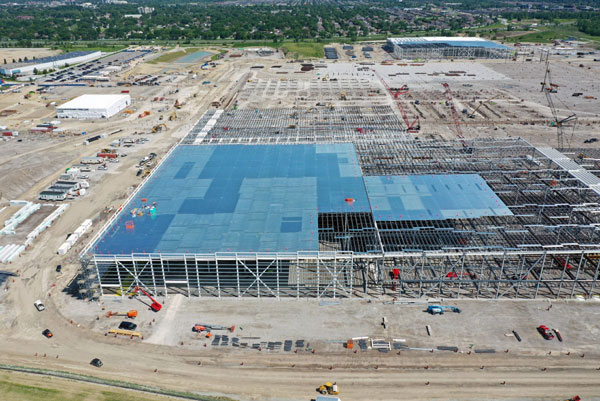Tensions over the hiring of Korean workers to help build NextStar’s $5-billion EV battery plant in Windsor, Ont. have eased significantly over the past six to 12 months as executives with Canada’s two largest building trades councils and others have found common ground with the project owner on critical labour force issues.
Sean Strickland, executive director of Canada’s Building Trades Unions, told delegates attending the recent Provincial Building and Construction Trades Council of Ontario in Windsor that there are currently only 59 foreign workers employed at the NextStar site.
This is a sharp difference from the 1,600 originally forecast in a tweet from Windsor Police in November 2023 and from lower estimates subsequently released.
Strickland said in his presentation that building trades leaders “pushed back hard” in sending the message that the trades will work in solidarity to protect union jobs.
‘We fought back hard’

“I’m fully convinced to this day that that was their plan, to have workers come in to do our work,” he said. “And so the support of our committee and the support of the affiliates here on the ground in Windsor, we fought back, and we fought back hard.
“You know, the federal government has $5 billion in production subsidies for this project to NextStar, which is Stellantis and LG. And if you’re going to do that, we better make sure that you’re not bringing in 1,600 workers. We have 1,600 workers right here in Windsor and southwestern Ontario who are technically skilled and ready to do the work.”
But both he and Marc Arsenault, business manager with the Ontario Building Trades, suggested in interviews the set of solutions developed during extended discussions with the owner came as the participants reached better understanding of their mutual needs. Among best practices the trades have learned and will adopt, Strickland and Arsenault said, they realize it’s vital to work with project owners as early as possible as projects are being developed.
Arsenault said the trades fell short in early relationship-building.
“The key thing coming out of NextStar is the retention of lessons learned,” said Arsenault. “We can take that lessons-learned data and develop a best-practice playbook that would be submitted in partnership with the Ministry of Labour, to say that when we’re attracting international investments to Ontario, we want to make sure that we don’t repeat mistakes, that we know that they need to be solved before we get too advanced on the project.”
The project was announced in 2022 as the first of its kind in Canada. NextStar briefly threatened to pull the plug last year before the federal and provincial governments boosted their pledged subsidies. It’s thought the plant will eventually cost taxpayers a combined $15 billion in support.
The project has two phases. In an update offered in July, NextStar said construction of the module building and installation of equipment was nearly complete with production of modules ready to start in September. Construction of the cell building’s exterior was approximately 90 per cent finished with interior construction and the installation of equipment just beginning.
NextStar did not respond to a request for comment. CEO Danies Lee stated this summer in a published interview that Stellantis and project partners are keeping to the existing schedule and scope with cell production scheduled to begin next fall — even as other projects across the province are delayed.
Arsenault explained that a year ago the Building Trades learned the process-equipment component of the project was going to be performed by a different constructor — NextStar would serve in that role, assigning work to multiple subcontractors, some of whom would use Korean specialist trades. Through discussions with NextStar that included Essex and Kent Building Trades Council business manager Jason Roe, Arsenault said, communications gaps were addressed, and the Building Trades were able to explain how their demand-supply tool, which tracks and allots the availability of various trades, could reinforce workforce certainty.
Ontario’s Ministry of Labour also played a key role in looking for solutions, Arsenault said.

Three-month rolling schedule
Eventually, Arsenault said, a three-month rolling schedule was developed to inform discussions on allotting trades to meet the work requirements of the process-equipment constructor.
“We have each trade measured on how many we’re going to have onsite, on a week-by-week basis, for the duration of the project, and where there’s bottlenecks, those trades can manage that,” he said.
Arsenault said the collaborators also agreed to leverage the work of the full-time worker co-chair on the joint health and safety committee, along with other resources, to improve communications, address safety concerns on the busy jobsite and provide feedback to the local union hiring halls and their training centres.
Asked what the high-water mark was of foreign workers on the project, Arsenault said the important number is that there are 2,000 construction workers employed on the project, the vast number Canadian, and all earning good pay cheques for their families.
“It’s working,” said Arsenault, but there is more work to be done.
Strickland said some of NextStar’s experience in other jurisdictions was with workforces without the same skills Ontario has in assembling complicated manufacturing plants.
“We’re not through it yet,” said Strickland. “We’re still continuing to work in dialogue, but I think we’re in a good place right now.
“We just have to remain vigilant and continue to work with the owner in the spirit of collegiality to maximize the number of Canadian jobs.”
Follow the author on X/Twitter @DonWall_DCN.





Recent Comments
comments for this post are closed